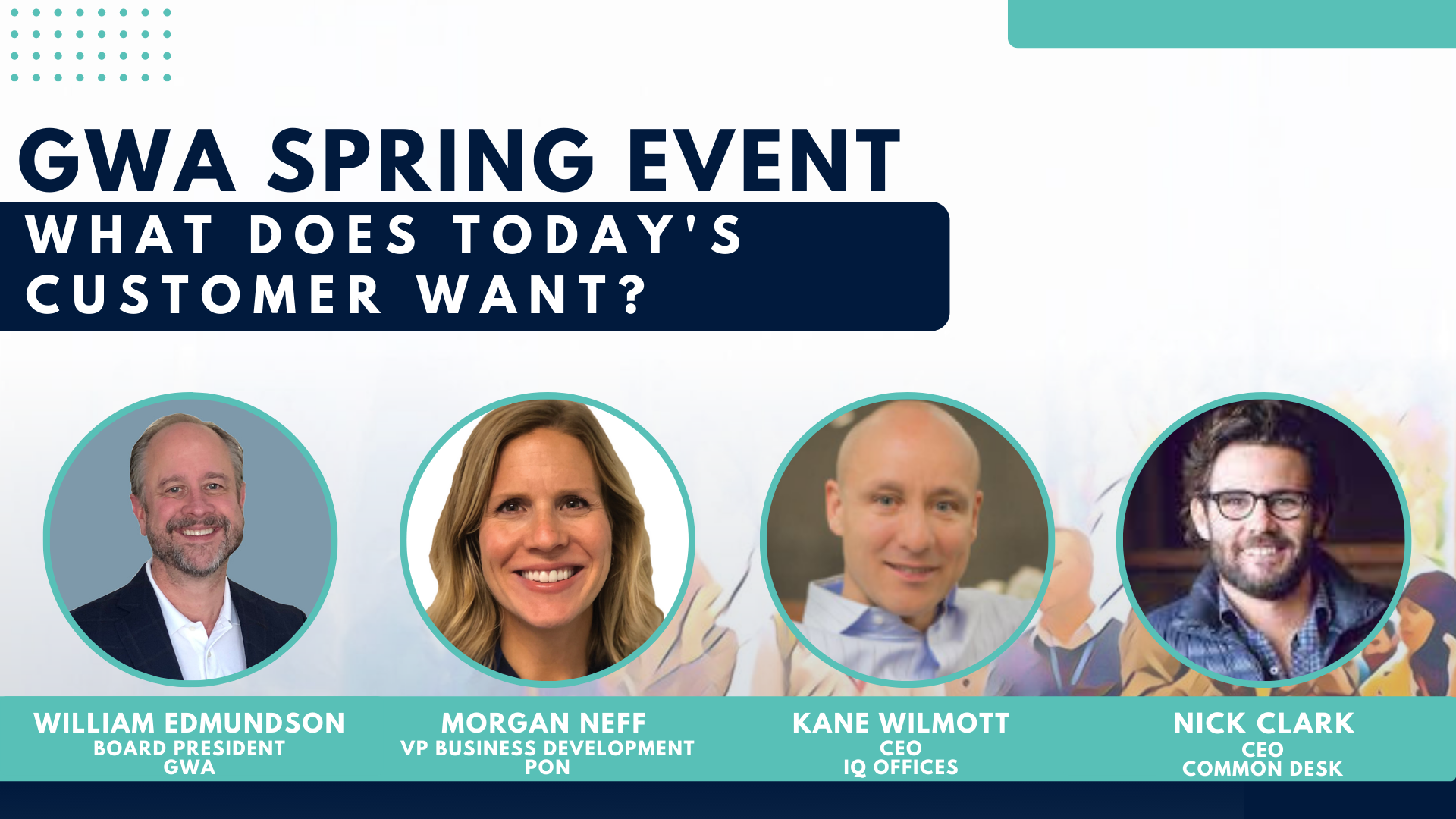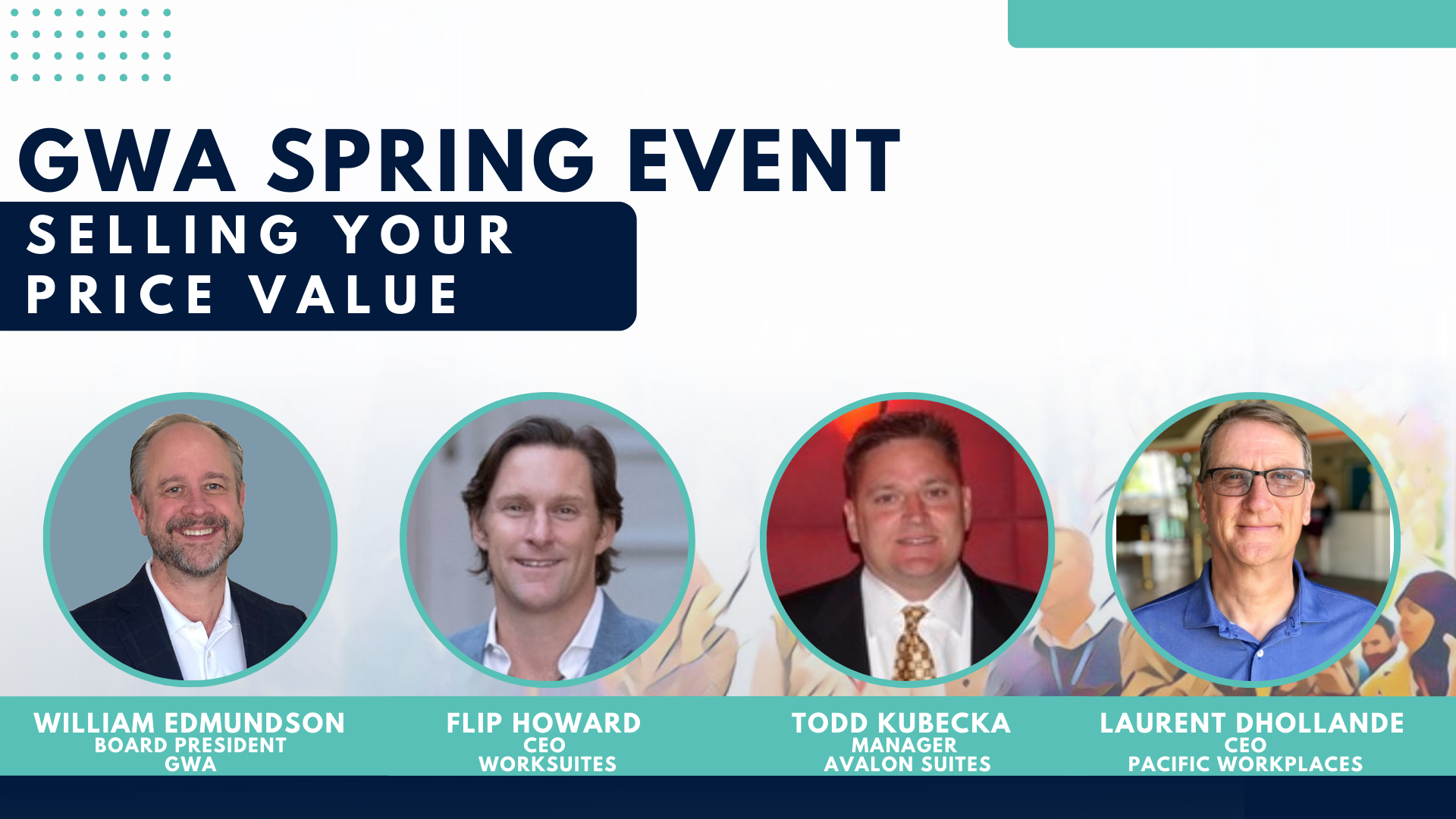GWA Spring Event 2021: Key Takeaways
A couple of weeks ago (May 12th, 2021), Nexudus was proud to sponsor GWA’s Spring Event, which focussed on flexible office operation in a post-covid marketplace. There were a number of fascinating sessions discussing the opportunities now presenting themselves to flexible workspace operators, as we start to move into a post-covid world.
This event brought together some of the leading names in the flexible workspace industry, who gave their insights into how this rapidly shifting marketplace is impacting the industry, and how operators can adapt not only to meet these changes but to truly take advantage of them. Unlike many industries, the coworking and flexible workspace market looks set to see a tremendous boost as we move into this much-touted “new normal”, so understanding how to take advantage of these changes is vital for spaces that want to emerge from the pandemic stronger and more stable than ever.
In this article, we will go over some of the most interesting sessions that were run in this virtual event and will go over the key takeaways from each of these sessions.
Standout Sessions
What does today’s customer want?

Kicking off the event was a stimulating panel discussion with Kane Wilmott, CEO, IQ Offices, Morgan Neef, VP Business Development at PON, and Nick Clark, CEO at Common Desk. They spoke to attendees about how people’s needs have shifted over the past year, and the way they have adapted to meet these changes.
This discussion largely focussed on enterprise companies, and how many of them have either closed or limited headquarter facilities. This move away from corporations wanting full-time offices has left flexible workspaces with the opportunity to fill their needs and as such gain considerably more business as a result. They agreed the central way to attract this new business would be based upon the flexibility and digestibility flex spaces can offer.
They noted how there is absolutely no one-size-fits-all approach, which is why flexibility needs to lie at the core of your offering. Panelists were keen to stress that much of the growth they were seeing was entirely market-specific. It was noted how successes or failures in having spaces busy with workers were very much down to both the local politics of a specific area, as well as the rate of cases in said areas as well.
In all, there was a very positive outlook from this session, and while the key takeaway was that all strategies must be tailored to the specific location you are operating in, in essence, people are looking for increased flexibility and a shorter commute, which coworking and flex spaces can certainly offer.
Adopting and defining flex strategies: What the data says
The second session of the event was a look into a survey undertaken by two industry providers. The purpose of this survey was to gain a deeper understanding of the landlord/tenant relationship and to identify trends in how both operators and landlords view flexible workspaces. The data used in this report was gathered from the responses of landlords and corporate enterprises based in the UK, North America, and Europe.
Right off the bat, the good news to come from this report is that dedicated flex space operators are very much here to stay. This was backed up by the data, which showed the majority of building owners are planning to move into flexible working over the next three years in order to adapt to the challenges of the future. This shows the strength of the position that flex space operators are in, as not only are they viewed favourably by clients, but many building owners are actively looking to partner with them.
Another key takeaway from the session was that landlords have significant ground to make up in terms of occupiers’ demands from increased flexible workspaces, however, the vast majority of landlords do see this as a genuine opportunity. Indeed, their report found that flex space operators and those partnered with landlords were seen as being in a very strong position by corporate enterprises. Conversely, they saw traditional landlords offering longer-term office leases as being in the weakest position. Interestingly, though, these corporate enterprises do not see smaller coworking networks as being in as strong a position, due to their desire for much more widespread network flexibility.
The key takeaway from the session, however, was that technology is going to be a major driver behind spaces’ ability to attract these new clients, both in terms of management and the level of professionalism expected from these spaces.
Understanding the value of virtual

The next session of the event saw a panel discussion looking into the value that virtual products can offer coworking and flexible workspaces. The panel included Ashley Buckner, COO of Carr Workplaces, a network of workspaces that have a very strong and successful virtual offering; as well as the CEOs of two of the largest virtual workspace providers, Matt Going of Anytime Mailbox and Martin Senn of Davinci Virtual.
So, what tips and tricks did these masters of virtual offerings suggest are considered to truly make this a viable option for more spaces to consider? Firstly, virtual offices were defined by the panel as any offering that is not tied to a fixed real estate product, the core feature obviously being a professional business address.
Ashley spoke about why virtual offices are such a valuable offering for people as the virtual product expands revenue streams and increases flexibility. This was highlighted over the pandemic where people were able to shift away from being into the office every day, without having to go through the difficulties of changing business addresses, phone numbers, business cards, etc. while still having the opportunity to go back to being in the office when they felt comfortable. It’s the flexibility that virtual offerings provide that is so attractive to members, particularly in such uncertain times.
In addition, due to there being no fixed real estate associated with virtual offices, the sky is very much the limit in terms of how many members you can attract. For instance, it’s not as though there are a finite number of virtual desks which might limit the number of members you are able to attract. This can be of particular importance for some spaces considering whether or not they need to increase their square footage, as setting up a virtual offering can provide the increased membership and subsequent revenue, at a fraction of the cost.
While some spaces might be concerned about seeing a decline in physical memberships if a virtual offering is provided, the response of the panel was not to worry! They spoke of how allowing virtual members of your centre to still book desks and meeting rooms on an ad hoc basis will help to maintain that income. Also, with these people being members of your network, they will be more likely to opt for your space in these scenarios than elsewhere.
Selling your price value

The final session of the day was a really exciting one. Following the initial shock of the pandemic many spaces massively reduced their prices to try and maintain their memberships. This panel discussion went over different ways spaces responded to these challenges, by selling on ‘price value’.
The concept of ‘price value’ means you aren't selling based on price alone, but instead the value of your complete offering. This can be based on your market circumstances, the strategies you chose to employ, and your position as an operator, These approaches rely heavily on transparency and what you are offering. Each of the panelists had different approaches to selling on ‘price value’, and this was the focus of the final session of the day.
Manager at Avalon Suites, Todd Kubecka, found the best way to meet the challenges of the pandemic when selling on price value was to make changes to their product offering by selling a lot more hourly and daily sales, as that was what his market was looking for. In terms of selling office space, he found they did not need to make too many changes. An interesting thought experiment Todd discussed was imagining an exact replica of your workspace on the floors above and below your space, and to work out how you would get people to opt for your space over these imagined alternatives. This forces you to think of the ‘value adds’, whether that be culture, amenities or any other factor. It’s this creative thinking that can be used to add value to your offering. In terms of attracting new prospects, they position themselves as somewhere that wants to help businesses grow, rather than somewhere simply providing office space. In this way, you discover prospects’ office needs through their business needs. The basis of this idea is that it reduces the need for you to beat competing spaces on price if you can convince prospects that their business will be better off in your space than any alternative one.
Flip Howard, CEO at Work Suites, echoed Todd’s sentiments and mentioned that even though their offering changed somewhat over the course of the pandemic, at no point did they reduce their price. This was significant, as what was usually a price differential of around $100 dollars pre-pandemic became a differential of nearly $500 dollars once competitors had opted for a far lower pandemic rate. Despite this though, Flip told attendees that their closing rate actually went up during the pandemic despite being twice as expensive as competitors. Largely he feels this is down to the belief that their offering is better than the alternatives. To do this, Work Suites focused on what differentiates them. What are their core competencies? What do they do better than their competitors? This way they were able to maintain their price integrity over a very turbulent period.
Laurent Dhollande, CEO at Pacific Workplaces, had a different perspective to the other panelists. Whilst they won't 'race to the bottom' on price, they aren't afraid to use price as a weapon. Laurent was keen to stress how, especially when it comes to Flexible Offices, prices can be very elastic, meaning repricing is very easy. Laurent’s main struggle over the course of the pandemic was attempting to maintain occupancy levels. Their aim is to always maintain occupancy at levels above 90%, so seeing it dip drastically for them over the past year was an issue. While there were incentives run to maintain existing members, driving new members was more problematic. Their response to this was to provide new members with 50% off the price and a 6-month deal, and 30% off a 12-month deal. This is clearly a monumental price reduction. The stress was on how you do this rather than whether you do it. In terms of the discount, they have been very open with members that this is not a long-term thing, and even display the amounts that will eventually need to be paid on each of their invoices. In this way, they are acknowledging the tough times we all find ourselves in, without completely undercutting and hiding the true cost of their product into the future.
For all those who attended the event, I’m sure you’ll agree how fantastic it was to hear from all these amazing panelists. We couldn’t have been more proud to sponsor the event and look forward to seeing what GWA comes up with next time they run one of their much anticipated events.
Related posts
-
Liz Elam: ‘Community is the number one amenity in coworking spaces’
A household name in the global coworking industry, Liz Elam, is the founder of one of the world’s best coworking event series: GCUC. Liz’s coworking roots began in 2010, when she established Link Coworking – a welcoming, affordable, and professional coworking space – in her hometown of Austin, Texas. Link Coworking achieved incredible success, expanding across three locations and becoming the fourth-largest coworking brand in Austin. It was sold in 2019, making Liz the first woman globally to exit a coworking brand.
-
Key Takeaways from the Coworking Alliance Summit 2025
Gathering online for the Coworking Alliance Summit last week, members of global coworking alliances, coworking spaces, and community leaders came together to navigate global issues, strengthen ties across the coworking industry, and work collectively towards future goals.
-
Key takeaways from the Workspace Design Show 2025
London’s Workspace Design Show is undoubtedly one of the best coworking events of 2025. For one, the exhibition (held at Islington’s Business Design Centre) features a host of innovative and creative workspace design solutions tailored to the needs of modern workplaces.
-
The Best Coworking Events in 2025: Must-Attend Gatherings for Professionals
Managing coworking spaces is an all-encompassing role, often leaving operators, owners, and community managers with little time to focus on personal growth or draw inspiration from others.
-
Blending Technology Into Physical Spaces: A Proptech Camp Retrospective
Discover the insights from Nexudus' recent Proptech Camp in Seville, an exclusive event where industry leaders converged to explore the future of real estate innovation.
-
Nexudus Pioneers the ‘Future of Workspaces’ at Space UK 2024
In our latest blog article, we delve into three key takeaways from the event "Space UK" that are reshaping the commercial real estate landscape.